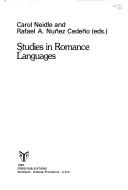| Listing 1 - 5 of 5 |
Sort by
|
Book
ISBN: 1589016521 1435674677 9781589016521 9781435674677 1589012127 9781589012127 Year: 2008 Publisher: Washington, D.C. Georgetown University Press
Abstract | Keywords | Export | Availability | Bookmark
 Loading...
Loading...Choose an application
- Reference Manager
- EndNote
- RefWorks (Direct export to RefWorks)
Brave New Digital Classroom deftly interweaves results of pedagogical research and descriptions of the most successful computer-assisted language learning (CALL) projects to explore how technology can best be employed in the foreign-language curriculum to assist the second language acquisition process.Directed to all language teachersùwhether at the school or the postsecondary level, with or without prior experienceùthis book focuses on how to use new technologies effectively. Blake urges teachers to move beyond a simple functional competence of knowing how to use the tools toward first a crit
Language and languages --- Computer-assisted instruction. --- Educational technology. --- Foreign languages --- Languages --- Anthropology --- Communication --- Ethnology --- Information theory --- Meaning (Psychology) --- Philology --- Linguistics --- CAI (Computer-assisted instruction) --- Computer-aided instruction --- Computer-assisted learning --- Computer based instruction --- Computer-enhanced learning --- Electronic data processing in programmed instruction --- ILSs (Integrated learning systems) --- Integrated learning systems --- Microcomputer-aided instruction --- Microcomputer-assisted instruction --- Microcomputer-assisted learning --- Microcomputer-based instruction --- Teaching --- Education --- Educational technology --- Programmed instruction --- Telematics --- Instructional technology --- Technology in education --- Technology --- Educational innovations --- Instructional systems --- Study and teaching --- Technological innovations. --- Data processing --- Aids and devices
Article
Abstract | Keywords | Export | Availability | Bookmark
 Loading...
Loading...Choose an application
- Reference Manager
- EndNote
- RefWorks (Direct export to RefWorks)
Book
ISBN: 1626167397 1626167400 1626167419 9781626167414 9781626167391 Year: 2020 Publisher: Washington, DC
Abstract | Keywords | Export | Availability | Bookmark
 Loading...
Loading...Choose an application
- Reference Manager
- EndNote
- RefWorks (Direct export to RefWorks)
Robert Blake, now with Gabriel Guillen, updates his successful book (1st ed. 2008, 2nd ed. 2013) on how to teach foreign languages using technology. Brave New Digital Classroom touches on all of the key concepts and challenges of teaching with technology of all kinds, focusing on issues specific to FLL or L2 learning. Originally referred to as computer-assisted language learning, CALL has come to encompass any kind of learning that uses digital tools for language learning. This book significantly updates and expands on the second edition reframing the conversation to account for the more integrated way technology is used in our lives. Starting at the beginning, Blake and Guillen ask, can technology help with L2? They then address the ways it can help, how to choose the right digital tools, how to use those tools effectively, finally expanding into a new area to explain how technology can impact literacy and identity. The book is primed for use in graduate courses. Key terminology is bolded and a comprehensive glossary is included. Each chapter finishes with a short list of references to consult for further reading on the topic and discussion questions. The authors will provide short interview videos (free via GUP website) to enhance discussions on the topics.
Unterrichtstechnologie --- Neue Medien --- Fremdsprachenunterricht --- Fremdsprachenlernen --- E-Learning --- Computerunterstütztes Lernen --- Language and languages --- Educational technology. --- Computer-assisted instruction. --- Second language acquisition --- Study and teaching --- Technological innovations. --- Foreign languages --- Languages --- Anthropology --- Communication --- Ethnology --- Information theory --- Meaning (Psychology) --- Philology --- Linguistics --- Second language learning --- Language acquisition --- Instructional technology --- Technology in education --- Technology --- Educational innovations --- Instructional systems --- Teaching --- CAI (Computer-assisted instruction) --- Computer-aided instruction --- Computer-assisted learning --- Computer based instruction --- Computer-enhanced learning --- Electronic data processing in programmed instruction --- ILSs (Integrated learning systems) --- Integrated learning systems --- Microcomputer-aided instruction --- Microcomputer-assisted instruction --- Microcomputer-assisted learning --- Microcomputer-based instruction --- Education --- Educational technology --- Programmed instruction --- Telematics --- Aids and devices --- Data processing --- Rechnerunterstütztes Lernen --- Computer --- CAL --- Computer aided learning --- Computer assisted learning --- Computer based training --- CBT --- Computergestütztes Lernen --- Lernen --- Computerunterstützter Unterricht --- Lernsoftware --- Learning on demand --- Telelearning --- Teleteaching --- Electronic Learning --- Virtuelles Lernen --- Computerunterstütztes Lernen --- Selbstunterricht --- Selbststudium --- Integriertes Lernen --- Fremdsprache --- Spracherwerb --- Gesteuerter Zweitsprachenerwerb --- Gesteuerter Fremdsprachenerwerb --- Zweitspracherwerb --- Fremdsprachenerwerb --- Fremdspracherwerb --- Sekundärer Spracherwerb --- Zweitsprachenerwerb --- Fremdsprachendidaktik --- Fremdsprachlicher Unterricht --- Sprachunterricht --- Neusprachlicher Unterricht --- Digitale Medien --- Elektronische Medien --- Neue Technologie --- Telekommunikation --- Informationstechnik --- Bildungstechnologie --- Erziehungstechnologie --- Pädagogische Technologie --- Lehrmittel --- Sprachenlernen --- Zweitsprache --- Spracherlernung --- Unterricht --- Digitales Lernen
Book
ISBN: 9781626162907 1626162905 Year: 2016 Publisher: Washington, DC Georgetown University Press
Abstract | Keywords | Export | Availability | Bookmark
 Loading...
Loading...Choose an application
- Reference Manager
- EndNote
- RefWorks (Direct export to RefWorks)
Spanish language --- Second language acquisition --- Study and teaching --- Foreign speakers


ISBN: 3110846306 9783110846300 9067652938 9067652946 9783110133509 3110133504 Year: 2010 Volume: 25 Publisher: Berlin Boston
Abstract | Keywords | Export | Availability | Bookmark
 Loading...
Loading...Choose an application
- Reference Manager
- EndNote
- RefWorks (Direct export to RefWorks)
Studies In Romance Languages (Publications In Language Sciences)
Romance languages. --- Neo-Latin languages --- Italic languages and dialects
| Listing 1 - 5 of 5 |
Sort by
|

 Search
Search Feedback
Feedback About UniCat
About UniCat  Help
Help News
News